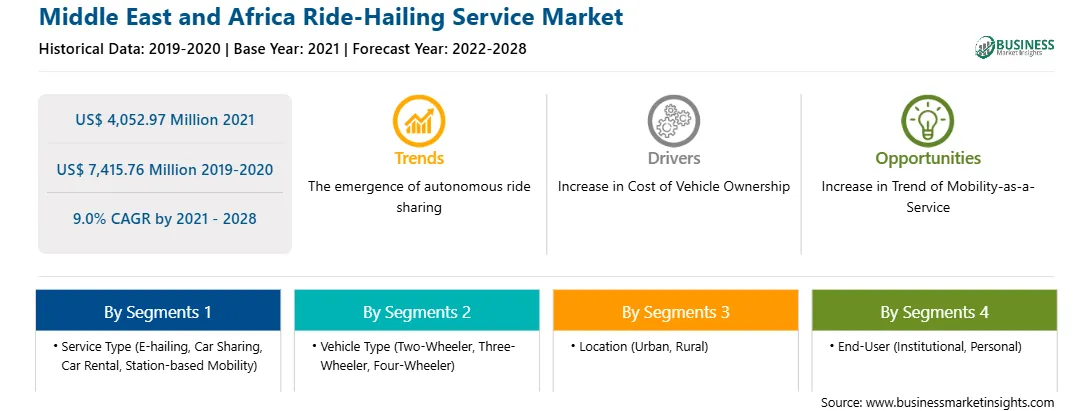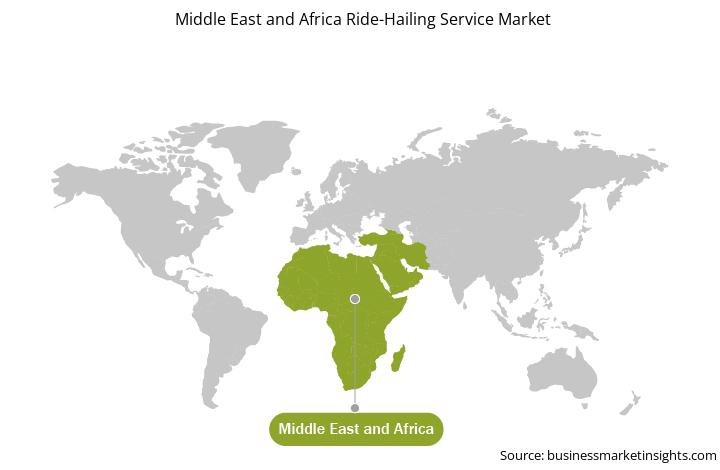Market Introduction
The Gulf countries are economically developed countries, whereas the African countries are yet to match up to the economic conditions of the Gulf countries and lag far behind. The commercial travelers, as well as tourism and religious travelers, are driving the demand for cabs in the Middle East & Africa region, owing to the region's developing business prospects. According to a report issued in March 2019 by the United Nations World Tourism Organization, the Middle East & Africa region had a 10% increase in international tourists in 2018, with about 87 million arriving in the region. In certain Middle Eastern countries, the huge cultural history, global connectivity, developed infrastructure, and business tourism are attracting a diversified tourist base. Saudi Arabia, Egypt, and the United Arab Emirates, for example, are the nations in the region that international tourists prefer, and major ride-hailing companies are spending heavily in these countries to meet the surging demand. Moreover, growing investments by the government of Saudi Arabia in infrastructure development to promote the travel and tourism sector has significantly increased the number of commercial spaces such as malls, resorts, hotels, restaurants, and tourist attractions in the country. This, in turn, is anticipated to drive the ride-hailing service market in the coming years. The African region is expected to witness substantial investments in infrastructure development owing to rapid urbanization and population growth in the coming years. Subsequently, the increasing number of airports, hospitals, ports, and commercial spaces across popular cities is expected to fuel the demand for ride-hailing service in the region.
Middle East & Africa (MEA) comprises of South Africa, the UAE, Saudi Arabia, and other countries. South Africa recorded the highest number of COVID-19 cases in the Middle East & Africa region and is followed by Saudi Arabia and the UAE. The government and healthcare authorities have enforced social distancing norms and restrictions that have limited the use of ride-hailing services for daily commutes. People have been forced to follow social distancing measures as a result of the increased risk of contamination associated with public transportation during the lockdown. Customers are becoming more interested in personal vehicles, which is impacting the ride-hailing service industry in 2020. Regardless of previous projections for steady growth of the ride-hailing service market in the MEA due to escalating development of commercial and residential buildings, corporate offices, and travel and tourism industry to enhance the implementation of mobility-as-a-service, the imposition of travel restrictions and social distancing norms in Saudi Arabia and the UAE are limiting the ride-hailing service market growth to a certain extent. However, after the pandemic, ride-hailing service market will very certainly surge.
Strategic insights for the Middle East and Africa Ride-Hailing Service provides data-driven analysis of the industry landscape, including current trends, key players, and regional nuances. These insights offer actionable recommendations, enabling readers to differentiate themselves from competitors by identifying untapped segments or developing unique value propositions. Leveraging data analytics, these insights help industry players anticipate the market shifts, whether investors, manufacturers, or other stakeholders. A future-oriented perspective is essential, helping stakeholders anticipate market shifts and position themselves for long-term success in this dynamic region. Ultimately, effective strategic insights empower readers to make informed decisions that drive profitability and achieve their business objectives within the market. The geographic scope of the Middle East and Africa Ride-Hailing Service refers to the specific areas in which a business operates and competes. Understanding local distinctions, such as diverse consumer preferences (e.g., demand for specific plug types or battery backup durations), varying economic conditions, and regulatory environments, is crucial for tailoring strategies to specific markets. Businesses can expand their reach by identifying underserved areas or adapting their offerings to meet local demands. A clear market focus allows for more effective resource allocation, targeted marketing campaigns, and better positioning against local competitors, ultimately driving growth in those targeted areas.Middle East and Africa Ride-Hailing Service Strategic Insights

Middle East and Africa Ride-Hailing Service Report Scope
Report Attribute
Details
Market size in 2021
US$ 4,052.97 Million
Market Size by 2028
US$ 7,415.76 Million
Global CAGR (2021 - 2028)
9.0%
Historical Data
2019-2020
Forecast period
2022-2028
Segments Covered
By Service Type
By Vehicle Type
By Location
By End-User
Regions and Countries Covered
Middle East and Africa
Market leaders and key company profiles
Middle East and Africa Ride-Hailing Service Regional Insights

Market Overview and Dynamics
The ride-hailing service market in Middle East & Africa is expected to grow US$ 4,052.97 million in 2021 to US$ 7,415.76 million by 2028; it is estimated to grow at a CAGR of 9.0% from 2021 to 2028. Finance, fuel, upkeep, registration/taxes, and maintenance & repair, as well as depreciation, all contribute to the cost of owning a car. The expense of owning a vehicle rises year after year. Fuel prices and maintenance expenses have risen dramatically in recent years, and the trend is expected to continue without any decline. Owning a car has become more of a liability than an asset as cities become increasingly congested with people and cars. As the millennial generation has little to no interest in owning a car, the percentage of people aged 18 to 35 who own a car has decreased over time. Other factors contributing to the fall in car ownership include poor public transportation connectivity in major cities and the growing popularity of internet shopping, among others. Though car ownership increased during the pandemic, it is anticipated to decline after 2021, returning to pre-pandemic levels. As a result, ride-hailing service providers can profit from these demographics, as the new tech-savvy generation is one of the most active users of these services.
Key Market Segments
In terms of service type, the E-hailing segment accounted for the largest share of the Middle East & Africa ride-hailing service market in 2020. In terms of vehicle type, the four-wheeler segment accounted for the largest share of the Middle East & Africa ride-hailing service market in 2020. In terms of location, the urban segment accounted for the largest share of the Middle East & Africa ride-hailing service market in 2020. In term of end-user, institutional segment held a larger market share of the ride-hailing service market in 2020.
Major Sources and Companies Listed
A few major primary and secondary sources referred to for preparing this report on the ride-hailing service market in Middle East & Africa are company websites, annual reports, financial reports, national government documents, and statistical database, among others. Major companies listed in the report are Daimler AG; Delphi Technologies Plc.; Didi Global Inc. Uber Technologies Inc.; and Gett among others.
Reasons to buy report
Middle East & Africa Ride-Hailing Service Market Segmentation
Middle East & Africa Ride-Hailing Service Market – By Service Type
Middle East & Africa Ride-Hailing Service Market – By
Vehicle Type
Middle East & Africa Ride-Hailing Service Market – By Location
Middle East & Africa Ride-Hailing Service Market – By End-User
Middle East & Africa Ride-Hailing Service Market – By
Country
Middle East & Africa Ride-Hailing Service Market – Companies Mentioned
The Middle East and Africa Ride-Hailing Service Market is valued at US$ 4,052.97 Million in 2021, it is projected to reach US$ 7,415.76 Million by 2028.
As per our report Middle East and Africa Ride-Hailing Service Market, the market size is valued at US$ 4,052.97 Million in 2021, projecting it to reach US$ 7,415.76 Million by 2028. This translates to a CAGR of approximately 9.0% during the forecast period.
The Middle East and Africa Ride-Hailing Service Market report typically cover these key segments-
The historic period, base year, and forecast period can vary slightly depending on the specific market research report. However, for the Middle East and Africa Ride-Hailing Service Market report:
The Middle East and Africa Ride-Hailing Service Market is populated by several key players, each contributing to its growth and innovation. Some of the major players include:
The Middle East and Africa Ride-Hailing Service Market report is valuable for diverse stakeholders, including:
Essentially, anyone involved in or considering involvement in the Middle East and Africa Ride-Hailing Service Market value chain can benefit from the information contained in a comprehensive market report.